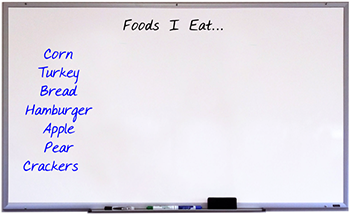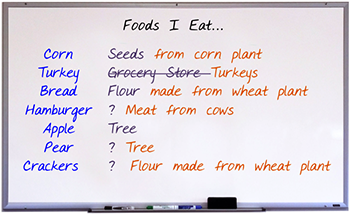 Relevancy and Engagement
dc.agclassroom.org
Relevancy and Engagement
dc.agclassroom.org
Animal or Plant? (Grades K-2)
Grade Level
Purpose
Students investigate the sources of different foods by differentiating between foods originating from plants and foods originating from animals. Grades K-2
Estimated Time
Materials Needed
- Index cards
- Crayons, colored pencils, or markers
- Small recyled cardboard boxes
- Example Food Cards (https://cdn.agclassroom.org/media/uploads/2015/03/16/Animal_or_Plant_Example_Food_Cards.pdf)
- How Did That Get In My Lunchbox? by Chris Butterworth
Vocabulary
crop: a cultivated plant that is grown and harvested, especially a grain, fruit, or vegetable
farmer: person who owns or manages a farm, cultivates land or crops, or raises animals
livestock: farm animals (such as cows, horses, and pigs) that are kept, raised, and used by people
Background Agricultural Connections
Nearly all the food we eat each day comes from either a plant or an animal. Most of these plants and animals were raised or grown on farms. Farmers and ranchers throughout the United States and the world work hard to learn how they can provide a nutritious and abundant food supply.
Animals raised on a farm are collectively called livestock. In the United States, the milk we drink and use to make dairy products such as cheese, yogurt, and ice cream is usually produced by cows. Goats are the next most common milk producing farm animal. Eggs are typically produced by chickens. Meat is provided by cattle, pigs, sheep, chickens, and turkeys. In addition to food, sheep also provide us with wool that makes the fabric commonly used for socks, coats, sweaters, and other clothing.
Farmers also grow plants that are used for animal feed, fuel, and food for humans. Some crops are raised to feed livestock, which in turn provide meat, milk, and eggs. Examples of crops raised for animal consumption include corn, soybeans, alfalfa, and grains such as wheat or barley. Other crops are raised for human consumption, including grains such as wheat and rice as well as various types of fruits and vegetables.
Engage
- Tell your students that they will be going on an imaginary field trip to a farm. Ask them to close their eyes as you describe the journey to them. Describe to the students the path they would take in your school to leave the classroom and board the bus. To help them visualize the field trip in their minds, use as many descriptive words as you can to describe what they would see along the way.
- Continue the description of your imaginary field trip as the students ride the bus and eventually arrive at the farm. Help the students visualize looking out the window of the bus and seeing the farm.
- Pause for a moment in your story to allow the students to visualize on their own what they might see if they were really visiting a farm. Then, ask the students to open their eyes and raise their hands to tell you what they would imagine seeing. Some students may list various farm animals and others may list items such as barns, fences, or crops.
- After the students have offered their ideas, inform them that they will be learning about the plants and the animals that are often found on farms.
Explore and Explain
- Open a discussion with the students by asking them what foods they typically eat in a day or week. List their responses on the whiteboard. Try to keep their responses limited to simple, raw foods that come purely from a plant or animal source and not both. If your students list food items such as pizza or a sandwich, only list a single part of the food (pepperoni, bread, or ham) to avoid confusion.

- Ask the students where they think these foods originate. Write their responses next to each food on the class list. For example, students may state that corn comes from the seeds of a plant. If they don't know where a food comes from, label it with a question mark. Keep their responses on display for future reference.

- Distribute crayons, colored pencils, or markers and several index cards to each student. Instruct them to draw a picture of one type of food on each card. Use the Example Food Cards (https://cdn.agclassroom.org/media/uploads/2015/03/16/Animal_or_Plant_Example_Food_Cards.pdf) as examples. If the students are able, ask them to write the name of their food under their illustration. Store each student's cards in an envelope or recycled cardboard box.
- Read the book How Did That Get in My Lunchbox? The Story of Food by Chris Butterworth to the class. Allow time for the students to react to the reading and discuss their ideas regarding the origination of their foods. As you read the book, ask the students to identify the origin of the described foods after you read each page. For example, "Does (bread) come from a plant or an animal?" Make changes to the class list of foods and originations as necessary.

- Have the students divide their index cards of food illustrations into two categories—foods from animals and foods from plants. Check student work for accuracy.
- Make this activity into a game. Divide the students into groups of 4-8. Provide two small boxes for each group to decorate. Label one box "Food from Plants" and the second box "Food from Animals." Take a selection of the food cards the group made and have the students mix them up. Instruct each group to look at the pictures and determine if the food originates from an animal or plant. Once a determination is made, students will place the card in the correct box. Check for accuracy.
Elaborate
-
Create short videos of students reporting about foods from animals or plants. Have the students use recycled materials to create a costume and give themselves a name, such as "Frank, the Food Reporter," for their reporting exercise. Video the class responses to the student illustrations or photographs of foods. Share the videos with parents and other family members.
-
Use a map of the world and a map of the United States to help students identify where in the world certain crops and livestock are raised. For example, corn in Iowa, peaches in Georgia, Kiwifruit in New Zealand, olives in Italy, etc. Discuss why certain areas of the world grow a specific crop or raise a particular animal.
-
Discuss food from other countries that might not be part of the typical US diet. Introduce foods like escargot, guacamole, tripe, and wasp crackers.
-
Invite a community member that is a practicing nurse or nutritionist to visit with students to share information about food groups and eating habits. Prior to the meeting, talk with students to determine what their questions are for the expert. Write these questions on a classroom whiteboard or chart paper. Have student questions in a visible spot in the classroom when the expert arrives. After the visit, arrange the students in small groups to talk about what they learned. Using crayons, students should illustrate what they have just learned about food choices. Encourage students to share their illustration and learning with parents and other family members.
-
Organize a class trip to a local farm. Prior to the trip, students should discuss what questions they have for the professional farmer. After the trip, have the students meet in small groups to discuss what they learned. Use crayons or colored pencils to illustrate their experiences.
Evaluate
After conducting these activities, review and summarize the following key concepts:
- Most foods we eat were produced on a farm and come from either a plant or an animal.
- Animals provide foods such as milk, meat, and eggs.
- Plants provide foods such as fruits, vegetables, and grains.
Acknowledgements
Adapted from Story County Farm Bureau by Jan Whaley
Recommended Companion Resources
- Eat Happy Project Video Series (https://dc.agclassroom.org/matrix/resource/822/)
- Farm Animals (https://dc.agclassroom.org/matrix/resource/245/)
- Farm Animals in a Box (https://dc.agclassroom.org/matrix/resource/1185/)
- Food Doesn't Grow in the Supermarket! (https://dc.agclassroom.org/matrix/resource/13/)
- How Did That Get in My Lunchbox? (https://dc.agclassroom.org/matrix/resource/194/)
- Livestock Cards (https://dc.agclassroom.org/matrix/resource/791/)
- Look Inside Food (https://dc.agclassroom.org/matrix/resource/258/)
- National Geographic Kids: Farm Animals (https://dc.agclassroom.org/matrix/resource/1278/)
- One Stubborn Goat (Farm Friends) (https://dc.agclassroom.org/matrix/resource/1301/)
- Pigs (https://dc.agclassroom.org/matrix/resource/205/)
- The Fruits We Eat (https://dc.agclassroom.org/matrix/resource/203/)
- The Goat Lady (https://dc.agclassroom.org/matrix/resource/622/)
- The Very Hungry Western Caterpillar (https://dc.agclassroom.org/matrix/resource/847/)
- Weslandia (https://dc.agclassroom.org/matrix/resource/598/)